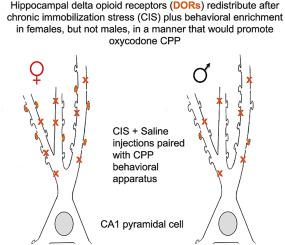Neurobiology of Stress ( IF 4.3 ) Pub Date : 2020-06-22 , DOI: 10.1016/j.ynstr.2020.100236 Batsheva R Rubin 1 , Megan A Johnson 1 , Jared M Berman 1 , Ellen Goldstein 1 , Vera Pertsovskaya 1 , Yan Zhou 2 , Natalina H Contoreggi 1 , Andreina G Dyer 1 , Jason D Gray 3 , Elizabeth M Waters 3 , Bruce S McEwen 3 , Mary Jeanne Kreek 2 , Teresa A Milner 1, 3

|
Following oxycodone (Oxy) conditioned place preference (CPP), delta opioid receptors (DORs) differentially redistribute in hippocampal CA3 pyramidal cells in female and male rats in a manner that would promote plasticity and opioid-associative learning processes. However, following chronic immobilization stress (CIS), males do not acquire Oxy-CPP and the trafficking of DORs in CA3 pyramidal neurons is attenuated. Here, we examined the subcellular distribution of DORs in CA1 pyramidal cells using electron microscopy in these same cohorts.
CPP
Saline (Sal)-females compared to Sal-males have more cytoplasmic and total DORs in dendrites and more DOR-labeled spines. Following Oxy-CPP, DORs redistribute from near-plasmalemma pools in dendrites to spines in males.
CIS
Control females compared to control males have more near-plasmalemmal dendritic DORs. Following CIS, dendritic DORs are elevated in the cytoplasm in females and near-plasmalemma in males.
CIS plus CPP
CIS Sal-females compared to CIS Sal-males have more DORs on the plasmalemma of dendrites and in spines. After Oxy, the distribution of DORs does not change in either females or males.
Conclusion
Following Oxy-CPP, DORs within CA1 pyramidal cells remain positioned in naïve female rats to enhance sensitivity to DOR agonists and traffic to dendritic spines in naïve males where they can promote plasticity processes. Following CIS plus behavioral enrichment, DORs are redistributed within CA1 pyramidal cells in females in a manner that could enhance sensitivity to DOR agonists. Conversely, CIS plus behavioral enrichment does not alter DORs in CA1 pyramidal cells in males, which may contribute to their diminished capacity to acquire Oxy-CPP.
中文翻译:

行为挑战后,性和慢性压力改变大鼠海马 CA1 锥体细胞内的 delta 阿片受体分布
在羟考酮 (Oxy) 条件性位置偏好 (CPP) 之后,δ 阿片受体 (DOR) 在雌性和雄性大鼠的海马 CA3 锥体细胞中以一种促进可塑性和阿片类药物相关学习过程的方式重新分布。然而,在慢性固定压力 (CIS) 之后,男性不会获得 Oxy-CPP,并且 CA3 锥体神经元中 DOR 的贩运减弱。在这里,我们在这些相同的队列中使用电子显微镜检查了 CA1 锥体细胞中 DOR 的亚细胞分布。
CPP
与 Sal-雄性相比,盐水 (Sal)-雌性在树突中具有更多的细胞质和总 DOR,并且具有更多 DOR 标记的刺。在 Oxy-CPP 之后,DOR 从树突中的近质膜池重新分布到雄性的刺中。
独联体
与对照雄性相比,对照雌性具有更多的接近质体树突状 DOR。在 CIS 之后,树突状 DOR 在女性的细胞质中升高,在男性的近质膜中升高。
独联体加 CPP
与 CIS Sal-雄性相比,独联体 Sal-雌性在树突的质膜和棘中具有更多的 DOR。在 Oxy 之后,DOR 的分布在女性或男性中都没有改变。
结论
在 Oxy-CPP 之后,CA1 锥体细胞内的 DOR 仍位于幼稚雌性大鼠中,以增强对 DOR 激动剂的敏感性,并在幼稚雄性中促进树突棘的运输,从而促进可塑性过程。在 CIS 加行为富集之后,DOR 在女性的 CA1 锥体细胞内重新分布,从而提高对 DOR 激动剂的敏感性。相反,独联体加行为丰富不会改变男性 CA1 锥体细胞中的 DOR,这可能导致他们获得 Oxy-CPP 的能力下降。









































 京公网安备 11010802027423号
京公网安备 11010802027423号